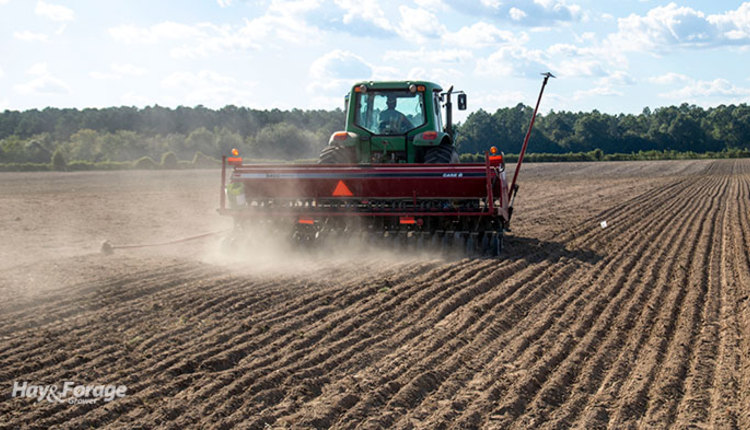
The window for planting annual and perennial grasses in the fall is a wide one, depending on latitude and what is being seeded. Even so, the basic components of establishing a productive stand remain the same.
“Planting is what we call a critical control point,” says Matt Poore, a professor and ruminant nutrition extension specialist at North Carolina State University. “If you do a really good job at that point, it helps with a good outcome far down the road. If you do a sloppy job, it will haunt you for the life of the crop.”
Poore, who is also the president of the Alliance for Grassland Renewal, recently outlined what he considers to be the key steps for obtaining a successful stand of perennial forages or winter annuals.
Manage the previous crop
Make sure soil pH and fertility are at least adequate before seeds are put into the ground. In a no-till situation, residue from the previous crop needs to be removed to prevent a physical barrier to germination or plant competition with the new seedlings.
Poore suggests haying off or mob grazing the current crop, or burning it down with an herbicide. Both actively growing plants and excessive amounts of dead residue will be detrimental to establishing a new stand. Tillage, if possible, can also be done to create a favorable seedbed.
Good seed
The decision of what seed to purchase is one that will have long-term ramifications, especially for perennials such as tall fescue. Performance potential and the quality of the seed need to be considered.
“Wise men frequently say ‘there is nothing more expensive than cheap seed,’ and that is so true,” Poore notes. “If you are planting annuals, you can try some new varieties each year and see how they do. You don’t have that opportunity with perennials. For example, if you are planting tall fescue, most forage agronomists would recommend using a novel endophyte-infected variety that carries not only the usual information on germination and purity but also the novel endophyte quality control tag from the Alliance for Grassland Renewal,” he adds.
Seeding rates need to be adjusted for germination percentage and purity. If the seed lot has 85% germination and 5% inert material, then a 15-pound per acre recommended seeding rate equates to about an 18.5-pound seeding rate to establish a sufficient number of seedlings.
Calibrate the drill
Ensure that your drill is ready for the field, which includes making sure all drop tubes are clear and there is no trash remaining in the seed box that might alter the seed metering mechanism.
“Also, you need to calibrate the drill each time you plant,” Poore warns. “Seed size and texture can both vary and that will influence how fast the seed flows through the drill. Nothing is more frustrating than having a lot of seed left over, except for running out of seed before you are done. Either situation can happen if you don’t calibrate.”
Watch your depth
Forage seed that is planted too deep is one of the primary causes of seeding failure. Poore suggests that tilled fields can be seeded by broadcasting or using a light grain drill followed by cultipacking. Where a grain drill is used, it’s helpful to roll or cultipack the seedbed prior to drilling. Seeding too deep can sometimes be a problem in a no-till situation if soils are too moist.
“Drills vary in how the depth is adjusted, but before you start, run the drill on some representative ground, assess how deep it is putting seed, and then adjust accordingly,” Poore suggests. “Some large-seeded annuals like rye, oats, or wheat are forgiving and can be planted at an inch or more in depth without creating problems, but smaller seeded perennials like novel endophyte tall fescue need to go in at a 1/4-inch depth, and that is sometimes a challenge,” he adds.
Check and double check
When seeding, it is important to stop periodically and assess seeding depth and ensure each row is planting.
“For a 1/4-inch desired depth, you should be able to see some of the seed sitting on the surface, otherwise, your depth setting is too deep,” Poore asserts.
Seeding gaps, either within the drill or between drill passes, can leave areas for weed encroachment. For larger drills, using row markers, foam markers, or a GPS system will ensure no large gaps are present between drill passes.
“Cross drilling” is a technique that can be used for perennials where two drill passes are made perpendicular to each other. Remember to cut your seeding rate in half when this approach is used. “Cross drilling makes for a denser canopy early in stand development, and also helps you correct for some of those missed spots that would be bare if you only drilled once,” Poore notes.
Attention to detail at seeding time, whether fall or spring, will set the stage for a productive, vigorous, and long-term perennial forage stand. “Just get it in” often isn’t good enough. Any shortcuts taken with fertility, seed selection, seedbed preparation, drill calibration, and drill performance will come back to “haunt” you for many years to come. Don’t overlook this “critical control point” in the life of a stand.

